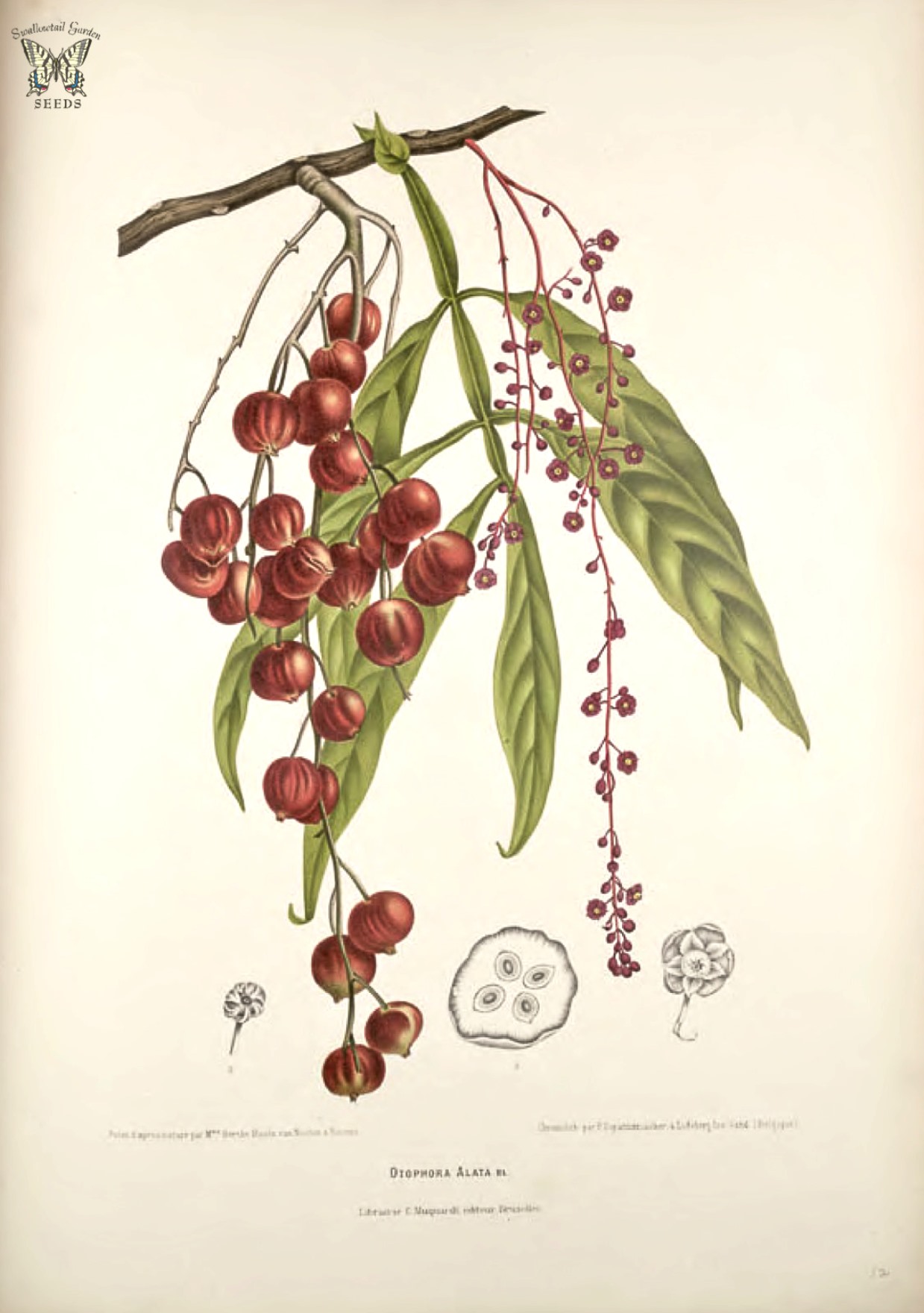Lepisanthes alata
Lepisanthes alata
The Chinese averrhoe (Lepisanthes alata (Blume) Leenh. 1969) is an arboreal species belonging to the Sapindaceae family.
Systematic –
From a systematic point of view it belongs to:
Eukaryota domain,
Kingdom Plantae,
Spermatophyta Superdivision,
Division Magnoliophyta,
Class Magnoliopsida,
Subclass Rosidae,
Sapindales Order,
Sapindaceae family,
Subfamily Sapindoideae,
Sapindeae Tribe,
Genus Lepisanthes,
Species L. alata.
The term is basionym:
– Otophora alata Blume.
The terms are synonymous:
– Capura alata (Blume) Teijsm. & Binn.;
– Lepisanthes alatus (Blume) Zoll.;
– Lepisanthes alatus (Blume) Zoll. ex Radlk.;
– Otolepis alata (Blume) Kuntze;
– Otophora edulis C.E.C.Fisch..
Etymology –
The term Lepisanthes comes from the Greek, from the two words “lepis”, i.e. scale, scale and “anthos”, i.e. flower, in reference to the scales at the apex of the petals.
The specific epithet alata comes from the Latin “alatus, a, um”, that is, winged, in reference to the winged spine.
Geographic Distribution and Habitat –
Lepisanthes alata is a plant native to south-east Asia, Indonesia (Kalimantan) and Malaysia (Johore, Sabah and Sarawak).
Its habitat is that of hilly mixed forests, on river banks, etc., on clayey soils at altitudes up to 500 meters above sea level.
Description –
Lepisanthes alata is a plant that grows in the form of a small tree, usually between 4 and 10 m in height.
The trunk grows to about 30 cm in diameter and the bark is greyish in colour.
The leaves are borne by a 2-10 cm long petiole, are impartipinnate, 20-50 cm long, with 3-6 pairs of opposite or subopposite leaflets, sessile or subsessile, with a lanceolate shape and a long pointed apex and a prominent central vein at the bottom; these are 8-15 cm long and 2-5 cm wide, initially light purple in colour, then green, the terminal leaflet, if present, is extremely small in size; petiole and rachis are provided with two wings up to 0.8 cm wide at the edges.
The inflorescences are generally pendant and composed of unisexual flowers on the same plant of about 8 mm in diameter, with 5 obovate sepals about 4 mm long and 5 orbicular petals, almost of the same size, of a purple colour.
The male inflorescences are in an axillary position; they are 20-30 cm long, with sessile fascicles of 3-5 flowers:
The female inflorescences are located in the axillary position or directly on the branches or trunk; they are up to 50 cm long, with generally solitary flowers on a pedicel about 1 cm long.
The fruits are obovoid-shaped berries, with a pointed apex, 3-4 cm in length and 2.5-3 cm in diameter; they have a variable color from red to dark purple, shiny when ripe.
Inside there are 1-4 ellipsoid-shaped seeds with white fleshy aril.
Cultivation –
Lepisanthes alata is a plant whose fruits are harvested in nature for local use. The tree is occasionally cultivated for its fruit in Indonesia as well.
It is a plant that grows mainly in tropical climates, with abundant rainfall from December to March, with a maximum in January and February and with a drier period from June to September.
From a pedological point of view, in nature, it is usually found on clayey soils.
Reproduction occurs by seed. This must be placed on an organic substrate, with the addition of 30% coarse sand or agri-perlite to improve drainage; it should be kept humid at a temperature of 25-28 °C. In these conditions, germination times are 2-4 weeks with first flowering starting from the fourth year of age.
Customs and Traditions –
Lepisanthes alata is a plant known by various common names, including: Chinese averrhoe, Johore fruit, Malaysian lepisanthes, trengganu cherry, blimbing china, ceri or engkili.
This plant is used by local populations where it grows in nature for its edible fruits.
The seeds are also likely to be eaten.
In some areas it is also cultivated. Additionally, because of its attractive foliage and production of decorative fruit, it is sometimes grown as an ornamental plant in tropical gardens.
In some local cultures, parts of the plant can be used not only for wood, but also for dyeing fabrics.
Preparation Method –
Lepisanthes alata is a tree that grows mainly in its natural state and is used in the food or medicinal fields.
This plant has in fact several traditional and potential uses, both for food and medicinal purposes:
The fruit is edible and is often eaten fresh. It has a sweet flavor, similar to lychee or rambutan. The fruit can be eaten alone or used in fruit salads, desserts or juices.
In some traditional cultures, parts of the plant, such as the leaves and roots, are used for medicinal purposes. They are believed to have healing properties, for example to treat gastrointestinal disorders, sore throats, coughs and other conditions. However, it is important to note that such medicinal uses may not be supported by robust scientific evidence.
The wood is occasionally used for craft purposes and in the production of lightweight furniture.
Guido Bissanti
Sources
– Acta Plantarum – Flora of the Italian Regions.
– Wikipedia, the free encyclopedia.
– GBIF, the Global Biodiversity Information Facility.
– Useful Tropical Plants Database.
– Conti F., Abbate G., Alessandrini A., Blasi C. (ed.), 2005. An annotated checklist of the Italian vascular flora, Palombi Editore.
– Pignatti S., 1982. Flora d’Italia, Edagricole, Bologna.
– Treben M., 2000. Health from the Lord’s Pharmacy, Advice and experiences with medicinal herbs, Ennsthaler Editore.
Photo source:
– https://inaturalist-open-data.s3.amazonaws.com/photos/38162782/original.jpeg
– https://upload.wikimedia.org/wikipedia/commons/4/41/Lepisanthes_alata.jpg
Attention: Pharmaceutical applications and food uses are indicated for informational purposes only, they do not represent in any way a medical prescription; we therefore decline any responsibility for their use for healing, aesthetic or food purposes.


